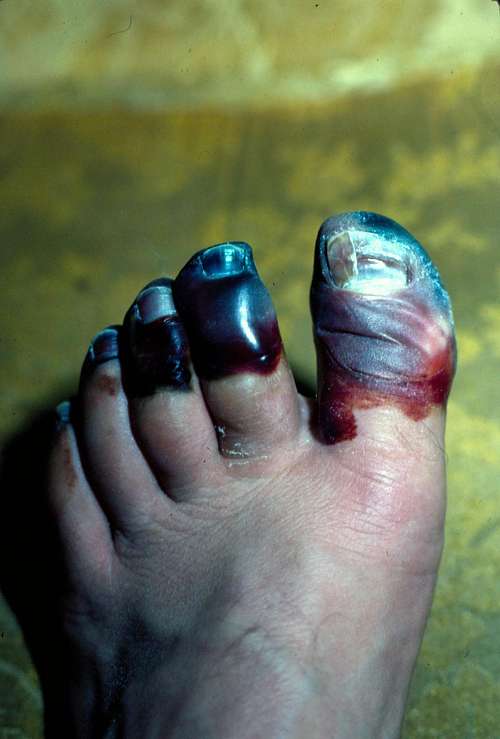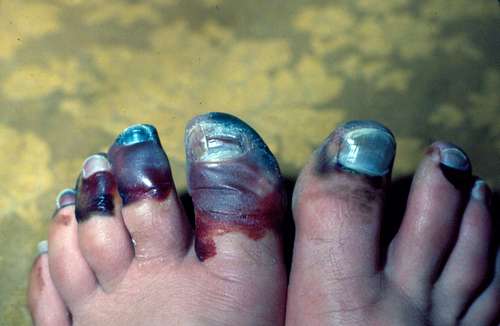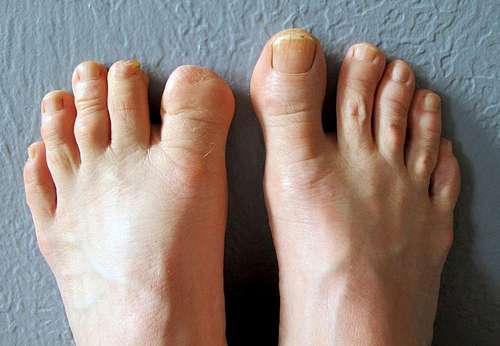Frostbite on the Mountain
I was reluctant to ever publish these pictures because I thought they were a bit shocking and frankly, I looked at them long enough during the healing process to never want to see them again. However, I think there might be some value in relating my experience to those who are ever so unfortunate as to suffer from frostbite. Over the years I heard about all kinds of treatment for frostbite like rubbing the frozen parts vigorously to soaking in warm water and even a few "old wives" tales of balms and natural potions. In my case, I faced the immediate amputation of parts of three toes since the standard of the day called for this in order to prevent gangrene. Fortunately, I was familiar with the work of Dr Cameron Bangs and his treatment of frostbite so I waited a few months before I went under the knife. If I recall, the advice was something like this: "delay surgery until you can determine the line of demarcation". During this time I carefully tended my feet daily and kept a watchful eye for any sign of infection. Frostbite injury is very similar to a burn with varying degrees of severity from first degree to third, the difference being the depth of damage.
![Frostbite Day 2]() Frostbite - Day 2
Frostbite - Day 2 | ![Frostbite - Day 7]() Frostbite - Day 5
Frostbite - Day 5
| ![Yikes!]() Frostbite - Day 30
Frostbite - Day 30
| ![Frostbite - Now]() Frostbite - 35 years later
Frostbite - 35 years later |
How, Why this Happened
I had a contributing factor with my frostbite in that I "nipped" my big toe on the same climb a few months earlier. Knowing that I was going to have to protect my feet much better for a January winter ascent, I purchased a pair of "moon boots" and spent a lot of time at home adjusting them prior to our climb. These particular overboots had a rubber bottom that fit over the sole of my boots and while I managed to get a perfect fit at home, putting them on while sitting on the side of a mountain at 20 below zero in a hellish, spindrift ground blizzard was another matter. While I was screwing around trying to get my overboots on my climbing partners were getting cold and started up the face ahead of me. Just when I thought I had them on correctly I started to climb and my crampon fell off. Feeling rushed, I sat down and took off my overboots and replaced them with my regular gators knowing that a dropped crampon higher up on the hard, steep ice was going to be a real problem. Doing this I made two mistakes. First; I let the pressure of being last push me to make a decision that I should have never made. Second; I ditched the overboots that would have protected my feet. I briefly considered a third decision and that was to do a "walk of shame" back to camp and let my friends do a first winter ascent of a route that Mike and I had put up 3 months earlier. This seemed unthinkable to me at the time but it certainly would have been the right decision and I'm sure other climbers face this kind of situation too. Plan and train for months or years, spend money, get to your destination, do the approach, get your shot at the top and then run into trouble and refuse to turn around. Well, it's like I was told, (unless it was Mt St Helens) "the mountain ain't going anywhere so what's your hurry?" As it turned out, the brutal winter cold spell we climbed in passed in a week and the temperature warmed to near spring like conditions for the remainder of the winter.
Conclusion
The first question I was asked after others had heard about my frostbite was "why didn't you take your boots off and warm your feet?" Tiring of answering the question, I started showing people the picture of where we were when I first knew my feet were freezing. I was on a 55 degree ice slope with no ledges and no where to stop. It was getting dark and the shortest and easiest way off the mountain was to finish the face and go down the easier side. As for taking off my boots, I knew from other accounts that taking my boots off could result in swelling and that it might not be possible to get them back on again. We also had a 5000' nighttime descent ahead of us and if I couldn't walk down I wasn't going to get off this mountain at all. I knew I was risking more damage in keeping my boots on but there were no other alternatives. When we did get down and I took off my boots my feet swelled up and I could not wear shoes again for almost two months. In order to sleep I had to make a tent at the bottom of my bed to keep the covers from touching my feet. The only thing I wore on my feet for over a month were my down booties.
The second question I was asked is "did it hurt?" My answer, "hell yes" but not at first. The freezing itself was totally painless but the healing process was quite painful and I had to go through it all over again later when I had the top of my big toe surgically amputated. My second toe, or Distal phalanx came off naturally in the bathtub when I removed the wrapping from my toes. Needless to say, I was surprised when I removed the wrap and didn't see the top of my second toe on my left foot. It was stuck to the bandage and no, I didn't save it. After surgery I had a post-op infection in my toe that caused me more pain than I had ever experienced in my life. I was forever humbled by the experience and learned exactly what my upper threshold for pain was. I also made sure that I never allowed myself to get into this kind of situation again.
Dehydration: Dehydration is perhaps the most common physical ailment that climbers and others involved in active sports experience. How many times have we put off taking a drink when we were pushing to make it to that designated rest spot only to keep pushing without taking a break? A lot of us would be my guess. There's no doubt in my mind that dehydration played a role in the severity of my frostbite. Outside of a short break we took on the lower face and what little moisture I could get out of my dried fruit or candy bar, I went around 16 hours without a drink of water. High up on the face, tied off to ice screws, we took our second break only to find our water bottles that were wrapped up in our packs and against our backs were frozen solid. Art had carried his water inside his down jacket in a bota bag and had barely a pint of water left when we topped out. Being extremely cold out, none of us really felt all that thirsty so we trudged down the mountain without drinking except for Art. When Mike and I got down to a frozen solid Rock Creek we were both hallucinating when twice we thought we saw running water in the creek. Both times we went down and tapped on the solid, clear ice thinking we might get a drink but only to find that our minds were starting to play weird tricks on us. I'm no physiologist but knowing that my body was fighting both dehydration and freezing at the same time just can't be good.












Comments
Post a Comment